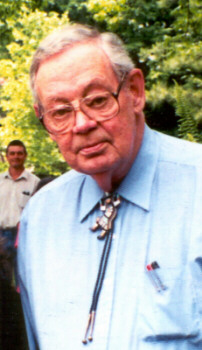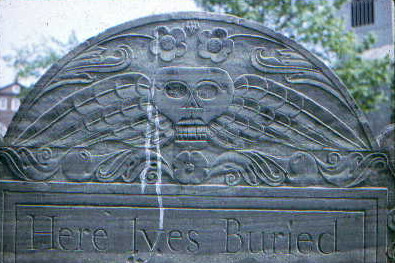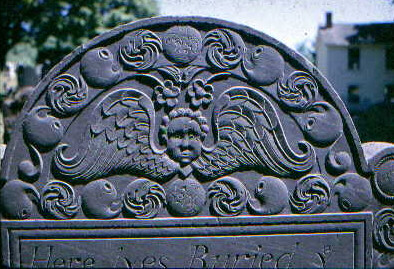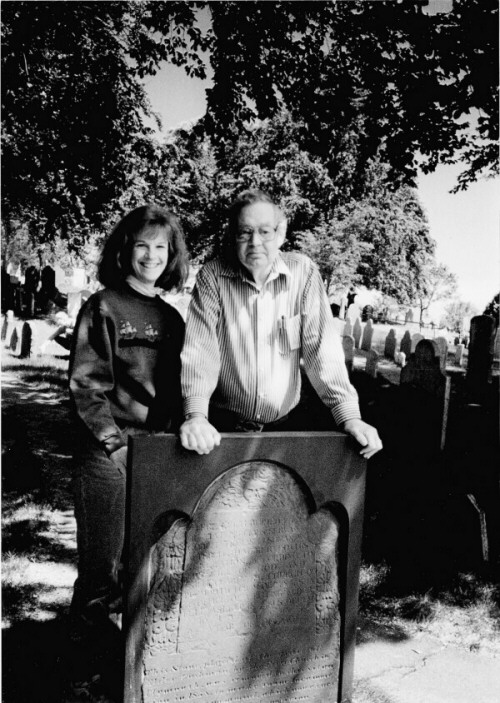Forbes Award Tribute
|
 |
Forbes Award Tribute
|
 |
The Association for Gravestone Studies awarded James Deetz and Edwin Dethlefsen the Harriette Merrifield Forbes Award in 2000, in recognition of their pioneering work in gravestone analysis. John Michael Vlach, Professor of American Studies at George Washington University, accepted this award on their behalf and provided the following tribute to their accomplishments. JAMES DEETZ (1930- ) and EDWIN DETHLEFSEN (1930-1991) (I'll refer to them here as Jim and Ted) met while graduate students at Harvard University during the early sixties. Jim would finish first, writing a dissertation on the Arikara, a Native American group in South Dakota, and then rise quickly to a place of prominence in the field of archaeology. He has not only served as president of the Society for Historic Archaeology but has authored books that are arguably among the most important texts for the field. His Invitation to Archaeology (1967) and In Small Things Forgotten: The Archaeology of Early American Life (1977) have become necessary readings for all would-be archaeologists. In Small Things... has gone through some twenty printings. Ted experienced a more modest level of success. His dissertation was completed in 1972 and he went on to teach at Franklin Pierce College in Rindge, New Hampshire. His last book, Whidah, Cape Cod's Mystery Treasure Ship (1984), focused on a topic not even hinted at by his graduate work. But when Ted and Jim were students, taking classes and sweating exams, they became partners in a project that transformed gravestone study in important ways. As Jim tells the tale, it was very hot during the summer of '62. Seeking some relief the two men decided to travel over to Concord where they relaxed in a shady graveyard while consuming roughly a gallon of beer. Comforted equally by the shade and the Ballantine ale, they looked out over the rows of ancient stones. It was then that Ted had the important flash of insight, "You know, you don't have to read the dates to tell when these stones were carved." His archaeological training in seriation linked to his recognition of discrete patterns of funerary icons revealed to him that the imagery changed consistently over time. Jim agreed that he was onto something and quickly plotted an ambitious research plan that might reveal the shifting patterns of culture over both time and space across a wide swath of southeastern New England. The boldness of their venture, sparked both by insight and beer, would lead to months of reconnaissance in cemeteries and the making of notes and photographs for thousands of stones. This was a transformative moment for archaeology because Ted and Jim were not digging into the ground like most of their colleagues. Surveying grave markers, they were doing aboveground archaeology and thus forging important links to architectural and art history, as well as to regional studies and genealogy. And they were attempting to explain not merely the iconography of the stones but the cultural values of the people buried under them.  This breakthrough was, however, cleverly disguised under a blanket of academic lingo. Their first report on their enterprising research was entitled "The Doppler Effect and Archaeology: A Consideration of the Spatial Effect of Seriation" (1965). The following year they were clearer about their discoveries in a joint paper, "Some Social Aspects of New England Colonial Mortuary Art," which was presented to the American Anthropological Association. But not until 1967 did they reach out to the general public with an article in Natural History, the magazine of the American Museum of Natural History. Now they spoke plainly and eloquently in "Death's Head, Cherub, Willow and Urn." Here they revealed the regular and steady shifts of customer preference in mortuary art from colonial times up to the era of New Republic. As Ted had discovered, one only needed to see the icon to know in what era it had been carved. They had made the stones "speak," mute objects had revealed something of their inner life. This proved to be both an archaeologist's dream and a delight to students of gravestones for often adequate written documentation is not always available for older stones. But when one could crack the cultural code shared between a decedent's family and a carver of gravestones, one had learned quite a lot.  While Jim became the more famous of this scholarly pair, Ted was sometimes listed as senior author in their dual publications and presentations. This was only fitting since it was he who had first been struck with the crucial intellectual thunderbolt. But given his meteoric rise to celebrity within archaeology and material culture studies, it fell to Jim to get the word out. He put discussions of New England gravestones before college freshmen all over the United States. Charts showing the steps by which death's heads were transformed into cherubs appear in Invitation to Archaeology. An entire chapter of In Small Things Forgotten, entitled "Remember Me As You Pass By," reviews in considerable detail the story of New England mortuary practices. The key point that he makes in his usual lucid prose is that graveyards tell us not merely about the ways of death but about how the people of that era viewed the world in which they lived. By linking gravestones to culture, Jim and Ted productively revolutionized both archaeology and gravestone research. Pushing, as they did, beyond the facts of production (who made this stone, when, where), they made it necessary to care about the circumstances of reception (who used this stone, for what reasons, and with what results). Jim Deetz and Ted Dethlefsen have considerably enriched the enterprise of gravestone study.

James Deetz with Nancy Brennan, Director of Plimoth Plantation, |
| A memorial fund has been established in Jim's honor to further promote the efforts of the Plimoth Plantation Living History Museum. Donations may be sent to: Plimoth Plantation P.O. Box 1620 Plymouth, MA USA 02362 |